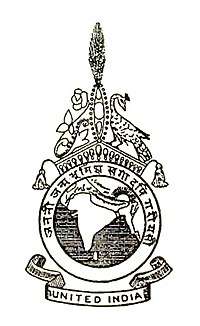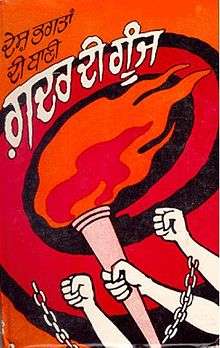Jugantar
Jugantar or Yugantar (Bengali: যুগান্তর Jugantor) (English meaning New Era or more literally Transition of an Epoch) was one of the two main secret revolutionary trends operating in Bengal for Indian independence. This association, like Anushilan Samiti started in the guise of suburban fitness club. Several Jugantar members were arrested, hanged, or deported for life to the Cellular Jail in Andaman.
Notable members
- Surya Sen (Masterda)
- Aurobindo Ghosh (1872-1950)
- Barin Ghosh
- Santi Ghose (1916-1989)
- Mohit Moitra
- Bhavabhushan Mitra
- Bagha Jatin alias Jatindra Nath Mukherjee (1879-1915)
- Satyendra Chandra Mitra (1888-1942)
- Raja Subodh Mallik
- Khudiram Bose
- Prafulla Chaki

- Pritilata Waddedar (1911-1932)
- Kanailal Dutta (1888-1908)
- Satyendranath Bose (1882-1908)
- Santosh Kumar Mitra (1901-1931)
- Dinesh Chandra Majumdar (1907-1934)
- Ganesh Ghosh (b. 1900 )
- Jadugopal Mukherjee (1866-1976)
- Roshomoy Majumdar (d.1996)
- Manoranjan Gupta (b. 1890)
- Abinash Chandra Bhattacharya (1882 - 1962)
- Amarendra Chatterjee (1880-1957)
- Ambika Chakrobarty (1891-1962)
- Arun Chandra Guha (b. 1892)
- Basanta Kumar Biswas (1895-1915)
- Bipin Behari Ganguli (1887-1954)
- Bhupendra Kumar Datta (1894-1979)
- Jiban Lal Chattopadhyay (1889-1970)
- Jyotish Chandra Ghose (1887-1970)
- Taraknath Das (1884-1958)
- Tarakeswar Dastidar
- Purna Chandra Das (1889-1956)
- Surendra Mohan Ghosh alias Madhu Ghosh(1893-1976)
- Prabodh Kumar Ray (1908-1996) in Andaman till 1938,Tamrapatra conferred 1972
- Upendra Nath Bandopadhyay (1879-1950)
- Ullaskar Dutta
- Phanibhusan Bakshi
- Debabrata Bose, later Swami Paragyananda
- Chattalesh Chaudhuri (1913-1987)[1]
- Ishwar Shukla, later Jayadutta Shastree (1892-1966)
The beginning
The jugantar party was established by leaders like Aurobindo Ghosh, his brother Barin Ghosh, Bhupendranath Datta, Raja Subodh Mallik in April 1906.[2] Barin Ghosh and Bagha Jatin were the main leaders. Along with 21 revolutionaries, they started to collect arms, explosives and manufactured bombs. The headquarters of Jugantar was located at 27 Kanai Dhar Lane, then 41 Champatola 1st Lane, Kolkata.[3]
Activities
Some senior members of the group were sent abroad for political and military training. One of the first batches included Surendra Mohan Bose, Tarak Nath Das and Guran Ditt Kumar, who, since 1907, were extremely active among the Hindu and Sikh immigrants on the Western coast of North America. These units were to compose the future Ghadar Party.[4] In Paris Hemchandra Kanungo alias Hem Das, along with Pandurang M. Bapat, obtained training in explosives from the Russian anarchist Nicholas Safranski. (Source: Ker, p397.) After returning to Kolkata, he joined the combined school of 'self-culture' (anushilan) and bomb factory run by Barin Ghosh at a garden house in Maniktala, a suburb of Calcutta. However, the attempted murder of Kingsford, the-then district Judge of Muzaffarpur by Khudiram Bose and Prafulla Chaki (30 April 1908) initiated a police investigation that led to the arrest of many of the revolutionaries. The prisoners were tried in the famous Alipore bomb conspiracy case in which several activists were deported for life to the Cellular Jail in Andaman.
In 1908, as a next step, Jugantar chose to censure persons connected with the arrest and trial of revolutionaries involved in the Alipore Bomb Case. On 10 February 1909, Ashutosh Biswas, who conducted the prosecution of Kanai and Satyen for the murder of Naren Gosain (a revolutionary turned approver), was shot dead by Charu Basu in the Calcutta High Court premises. Samsul Alam, Deputy Superintendent of Police, who conducted the Alipore Case was shot and killed by Biren Dutta Gupta on the stairs of Calcutta High Court building on 24 January 1910. Charu Basu and Biren Dutta Gupta were later hanged.[5]
Several including Jatindra Nath Mukherjee were arrested in connection with the murder of Police inspector Samsul Alam on 24 January 1910 in Calcutta and other charges. Thus started the Howrah-Sibpur Conspiracy case that tried the prisoners for treason, waging war against the Crown and tampering with the loyalty of Indian soldiers, such as those belonging to the Jat Regiment posted in Fort William, and soldiers in Upper Indian Cantonments.[6]
The German Plot
Nixon's Report corroborates that Jugantar under Jatindra Nath Mukherjee counted a good deal on the ensuing World War to organise an armed uprising with the Indian soldiers in various regiments.[7] During World War I the Jugantar Party arranged importation of German arms and ammunitions[8] (notably the 32 bore German automatic pistols) via Virendranath Chattopadhyay alias Chatto and other revolutionaries residing in Germany. They had contacted Indian revolutionaries active in the United States, as well as Jugantar leaders in Kolkata. Jatindra Nath Mukherjee informed Rash Behari Bose to take charge of Upper India, aiming at an All-Indian Insurrection with the collaboration of native soldiers in different cantonments. History refers to it as the Hindu German Conspiracy. To raise fund, the Jugantar party organized a series of dacoities which came to be known as Taxicab dacoities and Boat dacoities, in order to procure funds to prepare the ground for working out the Indo-German Conspiracy.
The first of the Taxicab dacoities took place at Garden Reach, Kolkata on 12 February 1915, by a group of armed revolutionaries under the leadership of Narendra Bhattacharya under the direct supervision of Jatindranath Mukherjee. Similar dacoities were organized on different occasions and in various parts of Calcutta. Dacoities were accompanied by political murders in which the victims were mostly zealous police officers investigating into the cases, or approvers who helped the police.
Failure of the German plot
On receiving instructions from Berlin, Jatindra Nath Mukherjee selected Naren Bhattacharya (alias M. N. Roy) and Phani Chakravarti (alias Pyne) to meet the German legation at Batavia. The Berlin committee had decided that the German arms were to be delivered at two or three places like Hatia on Chittagong coast, Raimangal in the Sunderbans and Balasore in Orissa. The plan was to organize a guerrilla force to start an uprising in the country, backed by a mutiny among the Indian Armed Force. The whole plot leaked out locally owing to a native traitor and, internationally, through the Czech revolutionaries who were in touch with their counterparts in the United States.,[9] and as soon as the information reached the British authorities, they alerted the police, particularly in the delta region of the Ganges, and sealed all the sea approaches on the eastern coast from Noakhali-Chittagong side to Orissa. Sramajibi Samabaya and Harry & Sons of Calcutta, the two business concerns run respectively by Amarendra Chatterjee and Harikumar Chakrabarti which were taking an active part in the Indo-German Conspiracy were searched. The police came to know that Bagha Jatin was in Balasore waiting for a German arms delivery. Police went on to find out the hiding places of Bagha Jatin and associates and after a gun-fight, the revolutionaries were either killed or arrested. The German plot thus failed.
Unification and failure
Following these major setbacks, and in the new circumstances of the colonial powers practising their divide and rule policy, there was an attempt to unify the revolutionary factions in Bengal. Anushilan Samiti and Jugantar were brought close by the joint leadership of Narendra Mohan Sen of Anushilan, represented by Rabindra Mohan Sen and Jadugopal Mukherjee of Jugantar, represented by Bhupendra Kumar Datta. However, this merger failed to revive the revolutionary activities up to the expected level.[10]
References
- Chaudhuri,Chattalesh https://archive.org/stream/in.ernet.dli.2015.86348/2015.86348.Indian-Recorder-1933_djvu.txt
- Shah, Mohammad (2012). "Jugantar Party". In Islam, Sirajul; Jamal, Ahmed A. (eds.). Banglapedia: National Encyclopedia of Bangladesh (Second ed.). Asiatic Society of Bangladesh.
- Mukhopadhyay Haridas & Mukhopadhyay Uma. (1972) Bharater svadhinata andolané 'jugantar' patrikar dan, p15.
- Political Trouble in India , by James Campbell Ker, pp220-260.
- Rowlatt Report; Samanta, op. cit.
- The major charge... during the trial (1910–1911) was "conspiracy to wage war against the King-Emperor" and "tampering with the loyalty of the Indian soldiers" (mainly with the 10th Jats Regiment) (cf: Sedition Committee Report, 1918)
- Samanta, op. cit. Vol II, p 591
- Rowlatt Report (§109-110)
- Spy and Counter-Spy by E.V. Voska and W. Irwin, pp98, 108, 120, 122–123, 126–127; The Making of a State by T.G. Masaryk, pp50, 221, 242; Indian Revolutionaries Abroad by A.C. Bose, pp232–233
- Islam, Sirajul (2012). "Revolutionary Terrorism". In Islam, Sirajul; Jamal, Ahmed A. (eds.). Banglapedia: National Encyclopedia of Bangladesh (Second ed.). Asiatic Society of Bangladesh.

